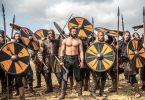| Fall fairs have been a feature of North American life since early in the nineteenth century. |
| At the end of the harvest, people from rural areas have come together to celebrate. |
| Usually, these fairs take the form of a competition regarding the best of all farm products of that year. |
| Depending on the part of the country, and its most important crop, |
| fall fairs can begin as early as August or as late as November. |
| They usually last several days. |
| When the United States and Canada were organized, they were divided into small units called counties. |
| Larger units were called states or provinces. |
| Many of the best-known fairs are county fairs or state fairs. |
| There are also smaller local fairs, |
| and larger ones too, like the Canadian National Exhibition in Toronto, Ontario. |
| Since these fairs are usually annual events, |
| many have developed permanent buildings over the years. |
| Most of these are large barn-like structures. |
| These buildings are used to display new products for farm life, |
| such as tractors, home furnishings and water systems. |
| Several barns are usually necessary to house all the horses, |
| cows, pigs, goats, sheep, chickens and other animals in competition. |
| There must also be room to display all the vegetables, berries and fruits in competition. |
| Finally, there is space for handicrafts, artwork, baked goods, and jams and jellies. |
| Usually, there is a grandstand, which is a stage with wooden seats around it. |
| Here entertainers perform for an audience during the fair. |
| Country and western singers are usually popular at fairs, |
| but so are comedians, clowns, dancers and musicians. |
| There may also be other contests such as a beauty competition for queen of the fair, |
| tests of strength for the men or pie-eating events. |
| Most fairs also have a racetrack, which is used for horse racing, or, in some cases, auto-racing. |
| Fairs have helped to improve animal breeds, and races encourage the breeding of fast horses. |
| Ploughing contests test the strength and steadiness of horses, and so do pulling contests. |
| This spirit of competition has led to improvements in all areas of farming. |
| Every kind of grain, fruit, vegetable, berry and animal is tested, and only the best win a ribbon. |
| This encourages fairness to improve their products. |
| Farm women compete to produce the best homemade food and crafts. |
| Many kinds of fruit and vegetables are stored in glass jars for the winter. |
| The best of these also receive prizes. |
| Most fairs have a dining area where there is good food served to the public. |
| The goal of improving farming is sponsored by the governments of Canada and the U.S.A. |
| Four-H Clubs are youth organizations that encourage farm children to take an interest in farming. |
| Four-H Clubs aim at improving the heads, hearts, hands and health of their members. |
| There are also women’s organizations, such as the Women’s Institutes in Canada, |
| which work to make the life of farm families better. |
| Fall fairs have taken over the idea of the midway from the circus. |
| The midway has rides like Ferris wheels, merry-go-rounds, and roller coasters. |
| It also has games of chance and skill, such as trying to throw a small hoop over a large bottle. |
| One nice thing about fall fairs is that they are fun for the whole family. |
| Children enjoy the midway and the farm animals. |
| Women like the crafts, food and household exhibits. |
| Men like the machinery, the horse races and the crop exhibits. |
| Everyone likes the grandstand shows. |
| Nowadays, not so many people live on farms. |
| But people from towns and cities still enjoy going to fall fairs. |
| They are part of our North American heritage. |
Subscribe
0 Comments
Oldest





